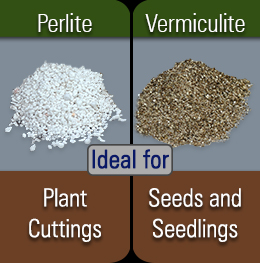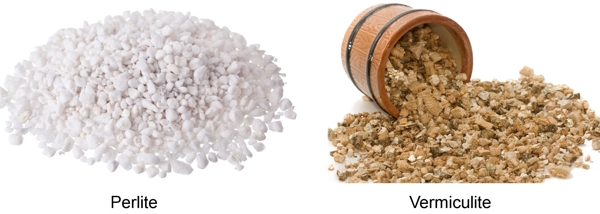Perlite and vermiculite are two inorganic soil amendments that help improve the quality of soil. Both are produced by expanding naturally available mineral materials, but despite this, the properties, uses, and appearance of these additives are not similar.

Heat ActivationWhile perlite and vermiculite are formed from different types of rocks, both minerals need to be expanded by heating at high temperatures, before they can be usead as soil additives.Soil amendments are organic and inorganic materials that are added to soil to improve its physical properties, including, water-retention, drainage, permeability, and aeration. Organic soil amendments include peat, ash, straw, compost, manure, sawdust, etc., whereas inorganic amendments include vermiculite, perlite, gravel, sand, etc. The organic category is specially used in cases where the nutrient content of the soil has to be increased. However, the most commonly used type are the inorganic variants of perlite and vermiculite.
While they serve the same purpose, they display a few differences that can help in determining the type of plant to be planted. Horticulturalists vary in opinion regarding the type that's better for gardening purposes. Hence it becomes necessary to know the specific differences between the two in order to determine the one suitable for your plants.Perlite Vs. Vermiculite

Source and Composition❖ It is a form of silica derived from volcanic rocks such as obsidian.
❖ It is an aluminum-iron-magnesium silicate derived from micaceous minerals.Formation❖ Crude ore is heated to 1472 - 1562 °F, causing the contained water to expand and form bubbles. This in turn causes the ore to expand up to 15 times its original size, and form perlite.
❖ Crude ore is heated to 1472 - 2012 °F. This causes the water content to escape in the form of steam, causing a 20 fold increase in size. Such an expansion is termed as "exfoliation".Physical Properties❖ Perlite is composed of white, porous granules, that have sharp edges.
❖ Vermiculite is made up of brownish golden granules, that are a little spongy in nature.Aeration❖ It has a high aeration property, due to its rigid shape and structure. It is favorable for growing plants that need good water drainage to thrive.
❖ It has a medium aeration quality. Due to its soft nature, air does not sufficiently penetrate through.Water Retention❖ It does not absorb any water on its own, but traps water in the spaces between the granules.
❖ Its soft nature allows it to absorb and hold water efficiently. It is ideal for plants that require moist soils to thrive.pH Buffering❖ It has a low capacity of pH buffering.
❖ It has a high capacity for pH buffering.Cation-exchange Capacity (CEC)❖ It has a very low, almost negligent capacity for absorbing cations from the soil and providing it to the plant.
❖ It has a medium cation-exchange capacity, due to its sponge-like nature.Best Suited For❖ It is ideal for growing plant cuttings, and for plants that need very well-drained and not very moist soil.
❖ It is ideal for planting seeds and seedlings. Also it is best suited for plants that require a lot of water and moist soil.Other Applications❖ It is used in industries as a filter for chemicals , food products, and water. It is also used as an abrasive in soaps and polishes, and as an insulator for the manufacture of bricks and mortars.
❖ It has a number of industrial uses. It is used in fire-proofing, as a blast mitigant, as a substrate for fungi cultivation, etc.Although both, perlite and vermiculite are used to improve soil conditions like aeration, water retention, etc, understanding the precise difference between the two would be helpful in selecting the appropriate soil additive for a plant to thrive.






 Heat ActivationWhile perlite and vermiculite are formed from different types of rocks, both minerals need to be expanded by heating at high temperatures, before they can be usead as soil additives.Soil amendments are organic and inorganic materials that are added to soil to improve its physical properties, including, water-retention, drainage, permeability, and aeration. Organic soil amendments include peat, ash, straw, compost, manure, sawdust, etc., whereas inorganic amendments include vermiculite, perlite, gravel, sand, etc. The organic category is specially used in cases where the nutrient content of the soil has to be increased. However, the most commonly used type are the inorganic variants of perlite and vermiculite.
Heat ActivationWhile perlite and vermiculite are formed from different types of rocks, both minerals need to be expanded by heating at high temperatures, before they can be usead as soil additives.Soil amendments are organic and inorganic materials that are added to soil to improve its physical properties, including, water-retention, drainage, permeability, and aeration. Organic soil amendments include peat, ash, straw, compost, manure, sawdust, etc., whereas inorganic amendments include vermiculite, perlite, gravel, sand, etc. The organic category is specially used in cases where the nutrient content of the soil has to be increased. However, the most commonly used type are the inorganic variants of perlite and vermiculite. Source and Composition❖ It is a form of silica derived from volcanic rocks such as obsidian.
Source and Composition❖ It is a form of silica derived from volcanic rocks such as obsidian.